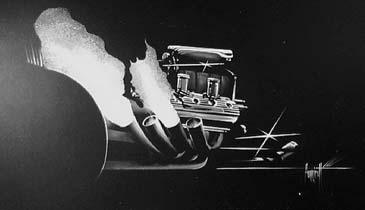|
|
|
"I was a teenage hot rodder!"
Are there any of us guys that never used a clothespin to attach a baseball card to the frame of their bicycle so it would flap in the spokes and sound like it had an engine? I used two of them. I rode a twin. I have a good recollection of the evening of my sixteenth birthday. It was March 7th, 1968. There was a 1930 Ford Model A sedan that appeared in that day's paper, and naturally since the asking price was the same amount as I had to my name at the time, and since I had the same amount of common sense as I have now, I went to have a look at it with my life savings in my pocket. It was a dark and cold winter night, in Winnipeg, Manitoba. The car was sitting in a snowbank, looking very much unwanted and unloved. Being both a motorhead and a meathead, I vowed right then that I would save her. When the snow melted in the spring I went to collect my first car, and realized that one should never buy a forty-year-old car when it's buried in snow. Rust, penetrating oil, broken bolts and rotted wood became my new hobbies, and I began to appreciate some of the reproduction stuff. As a matter of fact, after deciding I had just gotten mad at my once-beloved bucket of rusted and fatigued parts for the last time, I sold the car to a restoration type who was really happy with it. I wasted no time in ordering up a T-bucket body, pickup bed and frame, along with a Minnesota Auto Specialties four-inch-dropped tube axle, and had Jim Babb make me one of his beautiful brass radiators. Instead of fighting with old steel parts that had been together so long they couldn't understand being torn down, now I was making and buying parts. I was getting somewhere.
The hot rod progressed, and I was starting to realize what a pain this car was going to be when it was done. I had bought a GMC 6:71 blower from Bob Buccini, who ran a BB/Gas dragster out at our local track at the time, Keystone Dragway. The way I was planning on building this car, it should have run in the nines. But a T-bucket was never my dream car. Spending 300 bucks for a body and bare frame seemed to be a practical alternative to an unaffordable and hard-to-find original car in nice shape. (When the body arrived, I inspected it thoroughly for rust, and found none.) It's pretty hard to spend thousands of dollars on bodywork when all the body you have is a 'glass '23 T that you can carry with one hand. 1972 brought the so-called rebirth of hot rodding. One of its effects was to drive the price of Deuce parts out of sight. By this time I'd spent enough time thinking about what I wanted to build and what I wanted to do with it once it was done that a Deuce roadster I could run on the strip and the salt flats started to make sense, if I could afford one. Right on cue, Mike Martens, in Mendota, Illinois, announced in Rod & Custom that he was custom-building 1932 Ford frames, with hand-fabricated rails. I called him up, and he sounded real, so I sent him about $450 for a fully-boxed Deuce frame with mounts for a Chevy engine, four-speed and a Jag rear end. Unfortunately, between playing drums in rock bands and traveling constantly as a result, I was never able to complete that car and parted it out. The frame went to a couple who lived in Edmonton, Alberta. I'd like to know what's been done with it, since it was the first reproduction 1932 Ford frame in Canada.
'29s on Deuce rails, Deuces, the '33 and '34 Fords, the '39 and '40 Fords, the '40 and '41 Willys coupes...I love these cars. Here's to sunshine, a winding road and a healthy, strong hot rod.
|
 Around this time I was hanging around Bob Forzley Chassis Engineering. Bob was Canada's first SEMA-approved chassis builder and served as my race car guru. His
blown-392 Hemi dragster sat on one side of the shop, surrounded by welding equipment and pieces of chrome-moly tubing. Whenever I had the chance I drove Bob
crazy with questions. Since he was an incurable motorhead, he understood, and rewarded me with the honor of machining some engine parts for the digger.
Around this time I was hanging around Bob Forzley Chassis Engineering. Bob was Canada's first SEMA-approved chassis builder and served as my race car guru. His
blown-392 Hemi dragster sat on one side of the shop, surrounded by welding equipment and pieces of chrome-moly tubing. Whenever I had the chance I drove Bob
crazy with questions. Since he was an incurable motorhead, he understood, and rewarded me with the honor of machining some engine parts for the digger.
